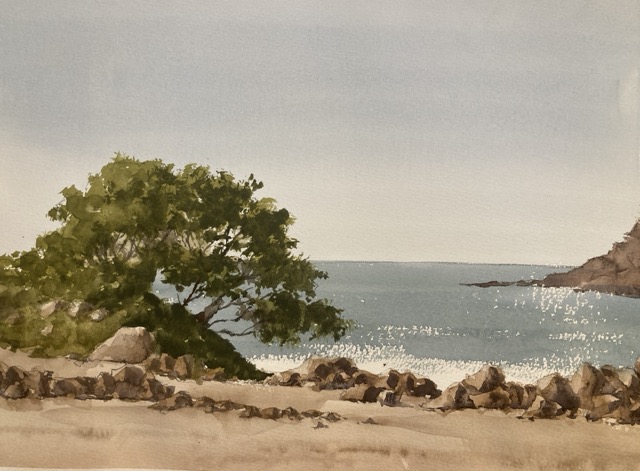A deceptively simple watercolor landscape value study was the precursor to this painting. Tuesday is teaching day so decisions had to be made and I plumped for this beach scene. It’s good for practice as there are obvious large shapes and clear values.
First a Small Landscape Value Study

Break the scene into big value shapes
The first thing was to break down the scene into a few large value shapes. These were the sky, the sand, the sea, the trees, and the rocks. A couple of these have multiple values in but I chose the average value in order to paint the study.
Sketch the shapes and identify the values
This is probably the most important part of the value study and it involves no painting at all! First I sketched the rough shapes in a small rectangle – probably about 4”x6”. Then Using my trusty Paul Centore value scale (buy from eBay) I first *estimated* what the value was for each shape. After taking a stab at the value I then brought in the value scale to check how close I was. If I’m within a step I’m pretty happy. It’s surprising how quickly you get better at this and the key to it is making a guess first rather than bringing in the scale immediately.
Note the values on the sketch
This is only a value study so we can mark it up however we want. I pencil in the value inside the shape so I can remember. So the sky and the sand were about a value 8. The sea was a 6 and the trees and rocks varied between a 5 and a 2. All these numbers went in the sketch.
Finally Paint the Value Study
And now we get to paint something. We’ve done a lot of the hard work here so it’s a case of mixing the value and painting it in the shape. I try and keep the value washes as even as possible so there aren’t stripes or brush marks. It keeps the values separated so we can judge how the composition is working. I usually do value studies in a sketchbook or on cheap student paper but this time I broke out the Fabriano Artistico. It’s not really needed as we’re not doing any edge work or blending but I had a small piece handy.
Some shapes have multiple values
The trees and the rocks have multiple values which show the form as the light hits them. In these shapes I used two values – a wash of the lighter value and then a much darker value on the shadow side to make them appear three dimensional.
There’s not a lot of detail in there. A few brush marks on the rocks brings everything together.
Assess the result
After I was done I stood back and assessed how the composition was working. In this case everything looked good. The value arrangement hung together and I was ready to go to the next stage. In particular I liked the way the sea was a mid value between the sky and the darks of the trees and rocks and tied the painting together. Another thing that I think worked well was the broad treatment of the rocks. I had used just two values and put in the shadows very broadly with a little softening of the edges. This simple treatment was surprisingly enough to make the rocks read well. Also the broad painting gives the study some energy and visual life.
Next Steps
In another post I’ll talk through the next stage which is mixing the colors. There are a couple of surprises in there which can catch you out. I have been caught unawares painting beach scenes quite recently and learned a few lessons which came in handy with this painting.
